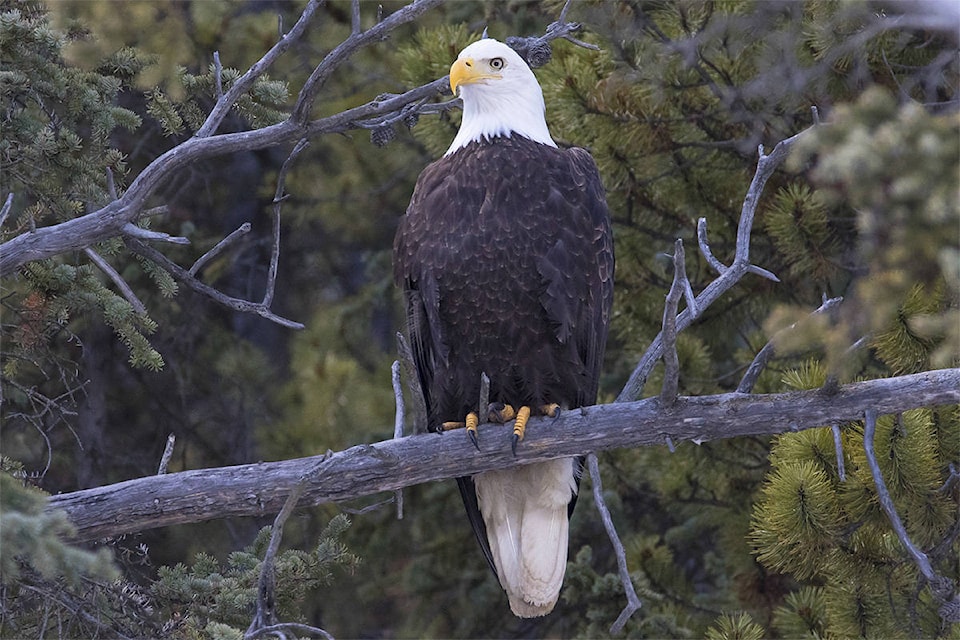Yukon bird-lovers, rejoice — one of the territory’s largest raptors is back for the season.
The smaller of the two eagle species found in the Yukon, the bald eagle typically heads to the coasts of Alaska or British Columbia to wait out the winter, returning to nest, mate and rear their young in the spring once the weather starts warming up again.
Like other migratory species, bald eagles likely come back to the territory to take advantage of resources that are more plentiful here than what they might find down south, said Katie Aitken, an instructor and coordinator with Yukon College’s environmental and conservation sciences program.
“It’s part of the life cycle that they have adapted to, and so there are a lot of benefits to coming north,” she said. “In the summer, there tends to be a lot more food availability here. We have longer days, vegetation tends to be very productive, there are a lot more insects which means there are a lot of potential prey species, so food tends to be more abundant here.”
The density of individuals also tends to be lower in the North, Aitken added, meaning less competition when it comes to food — waterfowl, small mammals and salmon are particular bald-eagle favourites, as well as easy scavenges like roadkill and leftovers at the landfill — or finding nesting sites.
The latter factor is particularly important for bald eagles, who build some of the largests nests in the feathered-creature kingdom — in fact, one bald eagle pair from Florida holds the Guinness World Record for largest bird nest ever, their creation coming in at 2.9 metres wide, six metres deep and an estimated weight of two tonnes. Bald eagles return to their nests year after year, adding more sticks, twigs and branches to them each time, an activity that not only reinforces the nests but also serves as an opportunity for pairs to bond.
“Generally, there will be a pair in the same area from year to year, sometimes using the same nest site, or they may have a few nest sites they’ll sort of rotate through over the years in an area…. Going out and locating twigs and bringing them back to the nest, that whole process and then building the nest will be sort of a bonding experience for them, that’s a way of them displaying their bond,” Aitken said.
That bond is mostly just seasonal though, she added — although bald eagles may congregate in large groups outside of mating season to, for example, take advantage of the salmon run in the late summer and fall, individual birds mostly live solitary lives.
“They’re not social in the sense that they’d be hanging out together … the way you would find, say, ravens doing,” she said.
Currently, though, bald eagle pairs in the Yukon are well into the bonding-over-nest-building phase, Aitkens said, and some particularly eager birds may already be incubating eggs. Female bald eagles typically lay one to three eggs per year, with the eaglets hatching in May or June. Although bald eagles are typically at the top of the food chain, their eggs and young eaglets are vulnerable to predators like gulls, hawks and ravens.
“You’ll see eagles being very, very protective of their nests during the incubation stage when they have eggs and when the nestlings are quite young,” Aitken said. Typically, there’s always at least one parent watching over the nest, and both birds in a pair will take turns hunting both for themselves and their eaglets. The eaglets can pull apart and eat chunks of raw meat right from the beginning and quickly put on weight and size, typically taking their first flights when they’re about 12 weeks old. Younger eagles have black beaks and mottled plumage, gradually developing their distinctive yellow beaks and white-feathered heads over about five years.
For people in the Whitehorse area eager to catch a glimpse of the eagles this season, Aitken said there are several well-established pairs to be found in and around the city. One pair usually nests on a platform found at the pull-off along Robert Service Way just past the Robert Service Campground, with other pairs also known to set up shop on the clay cliffs nearby. Fish Lake Road is another well-established bald-eagle watching site, Aitken said, with lots of activity throughout Rabbit’s Foot Canyon and the McIntyre Creek wetlands.
There’s also a prime location that may seem a little less glamorous at first, but will almost guarantee a sighting.
“The dump is an excellent eagle viewing location,” Aitken said with a laugh. “Seems weird to say, but it is.”
Contact Jackie Hong at jackie.hong@ykuon-news.com
